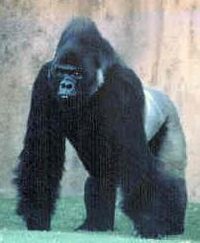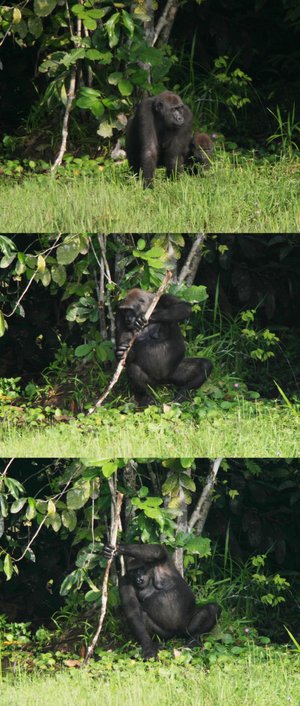Gorilla
The gorilla, the largest of the primates, is a ground-dwelling herbivore that inhabits the forests of central Africa. There are two species of gorilla, both in the genus Gorilla; each species has two subspecies. more...
Both species of gorilla are endangered, and have been subject to intense poaching for a long time. Threats to gorilla survival include habitat destruction and the bushmeat trade.
All gorillas share a single blood type, B.
Physical characteristics
Gorillas move about by knuckle-walking. Adult males range in height from 1.65 m to 1.75 m, and in weight from 140 kg to 165 kg. Females are about half the weight of males.
Gestation is 8 ½ months. There are typically 3–4 years between births. Infants stay with their mothers for 3–4 years. Females mature at 10–12 years (earlier in captivity); males 11–13 years, sometimes sooner if they assume leadership early. Lifespan is between 30–50 years. The Philadelphia Zoo's Massa set the longevity record of 54 years at the time of his death.
Gorillas are mainly vegetarian, eating fruits, leaves, and shoots. Insects make up 1-2% of their diet.
Strength
To date, no research has been conducted into how strong gorillas are compared to humans. Comparisons cannot be made very easily. Some people say that a silverback male is ten times stronger than a man while others claim a silverback is 27 times stronger. However, neither argument has been proved. A gorilla male probably looks much stronger than he actually is, as he doesn't have that much more muscle tissue than humans.
Even so it is very difficult to bring gorillas under control when they are aggressive or when they are panicking. Even a four-year-old gorilla is difficult for a single person to control.
Gorilla culture
A silverback is an adult male gorilla, typically more than 12 years of age and named for the distinctive patch of silver hair on his back. A silverback gorilla has large canines that come with maturity. Blackbacks are sexually immature males of up to 11 years of age.
Silverbacks are the strong, dominant troop leaders. Each typically leads a troop of 5 to 30 gorillas and is the center of the troop's attention, making all the decisions, mediating conflicts, determining the movements of the group, leading the others to feeding sites and taking responsibility for the safety and well-being of the troop.
Males will slowly begin to leave their original troop when they are about 11 years old, travelling alone or with a group of other males for 2–5 years before being able to attract females to form a new group and start breeding. While infant gorillas normally stay with their mother for 3–4 years, silverbacks will care for weaned young orphans.
If challenged by a younger or even by an outsider male, a silverback will scream, beat his chest, shake broken-off branches at the intruder, bare his teeth then charge forward. If he is killed by disease, accident, fighting or poachers, the group will split up or be taken over in its entirety by a male descendant or even an unrelated male; there is a strong risk that a new male may kill the infants of the dead silverback.
Read more at Wikipedia.org





